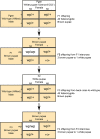A New Diagnostic Resource for Ceratitis capitata Strain Identification Based on QTL Mapping
- PMID: 28889103
- PMCID: PMC5677166
- DOI: 10.1534/g3.117.300169
A New Diagnostic Resource for Ceratitis capitata Strain Identification Based on QTL Mapping
Abstract
The Mediterranean fruit fly Ceratitis capitata (Wiedemann) is a destructive agricultural pest and the subject of exclusion efforts in many countries. Suppression and eradication of invasive populations to prevent its establishment is facilitated by the release of sterile males using the sterile insect technique (SIT). In SIT release areas, it is critical to accurately discriminate between released sterile males and wild individuals to detect extremely rare invasive individuals in areas inundated with millions of sterile male flies. Current methods for discrimination exist but are not always definitive, and a more reliable method is necessary. To address this, we developed a genotyping assay that can be used to discriminate between sterile males from the SIT strain and wild individuals. This was achieved by identifying single nucleotide polymorphisms (SNPs) linked to the maintained traits that facilitate male-only releases, white pupae (wp) and temperature-sensitive lethal (tsl), via QTL mapping. This resulted in the identification of one SNP that was in near-perfect linkage disequilibrium between genotype at this locus and the pupal color phenotype. Medfly from many SIT colonies and wild individuals from across its geographic range were genotyped for this locus, and results show its consistency in identifying SIT flies. In addition, linkage and QTL mapping of wp and tsl have larger impacts as they can serve as foundational tools to identify the genetic basis of traits that facilitate the separation of males from female flies, which can be used to develop SIT programs in related species.
Keywords: QTL; diagnostics; genome-wide genotyping; linkage mapping; medfly; sterile insect technique.
Copyright © 2017 Sim et al.
Figures






Similar articles
-
Mitochondrial Single Nucleotide Polymorphisms in Ceratitis capitata (Diptera: Tephritidae) Can Distinguish Sterile, Released Flies from Wild Flies in Various Regions of the World.J Econ Entomol. 2015 Feb;108(1):301-6. doi: 10.1093/jee/tou027. Epub 2015 Jan 24. J Econ Entomol. 2015. PMID: 26470134
-
Deep orange gene editing triggers temperature-sensitive lethal phenotypes in Ceratitis capitata.BMC Biotechnol. 2024 Feb 1;24(1):7. doi: 10.1186/s12896-024-00832-x. BMC Biotechnol. 2024. PMID: 38302991 Free PMC article.
-
The whole genome sequence of the Mediterranean fruit fly, Ceratitis capitata (Wiedemann), reveals insights into the biology and adaptive evolution of a highly invasive pest species.Genome Biol. 2016 Sep 22;17(1):192. doi: 10.1186/s13059-016-1049-2. Genome Biol. 2016. PMID: 27659211 Free PMC article.
-
Genetic sexing strains in medfly, Ceratitis capitata, sterile insect technique programmes.Genetica. 2002 Sep;116(1):5-13. doi: 10.1023/a:1020951407069. Genetica. 2002. PMID: 12484522 Review.
-
How functional genomics will impact fruit fly pest control: the example of the Mediterranean fruit fly, Ceratitis capitata.BMC Genet. 2014;15 Suppl 2(Suppl 2):S11. doi: 10.1186/1471-2156-15-S2-S11. Epub 2014 Dec 1. BMC Genet. 2014. PMID: 25471105 Free PMC article. Review.
Cited by
-
Genomic and cytogenetic analysis of the Ceratitis capitata temperature-sensitive lethal region.G3 (Bethesda). 2023 Jun 1;13(6):jkad074. doi: 10.1093/g3journal/jkad074. G3 (Bethesda). 2023. PMID: 36988332 Free PMC article.
-
Conservation of shibire and RpII215 temperature-sensitive lethal mutations between Drosophila and Bactrocera tryoni.Front Insect Sci. 2024 Mar 4;4:1249103. doi: 10.3389/finsc.2024.1249103. eCollection 2024. Front Insect Sci. 2024. PMID: 38469341 Free PMC article.
-
White pupae phenotype of tephritids is caused by parallel mutations of a MFS transporter.Nat Commun. 2021 Jan 21;12(1):491. doi: 10.1038/s41467-020-20680-5. Nat Commun. 2021. PMID: 33479218 Free PMC article.
-
Disjunction between canola distribution and the genetic structure of its recently described pest, the canola flower midge (Contarinia brassicola).Ecol Evol. 2020 Oct 26;10(23):13284-13296. doi: 10.1002/ece3.6927. eCollection 2020 Dec. Ecol Evol. 2020. PMID: 33304537 Free PMC article.
-
Lessons from Drosophila: Engineering Genetic Sexing Strains with Temperature-Sensitive Lethality for Sterile Insect Technique Applications.Insects. 2021 Mar 13;12(3):243. doi: 10.3390/insects12030243. Insects. 2021. PMID: 33805657 Free PMC article. Review.
References
-
- Andrewartha H. G., Birch L. C., 1960. Some recent contributions to the study of the distribution and abundance of insects. Annu. Rev. Entomol. 5: 219–242.
-
- Barr N. B., 2009. Pathway analysis of Ceratitis capitata (Diptera: Tephritidae) using mitochondrial DNA. J. Econ. Entomol. 102: 401–411. - PubMed
-
- Bassett A., Liu J. L., 2014. CRISPR/Cas9 mediated genome engineering in Drosophila. Methods 69: 128–136. - PubMed
-
- Broman K. W., Wu H., Sen S., Churchill G., 2003. R/qtl: QTL mapping in experimental crosses. Bioinformatics 19: 889–890. - PubMed
Publication types
MeSH terms
LinkOut - more resources
Full Text Sources
Other Literature Sources
